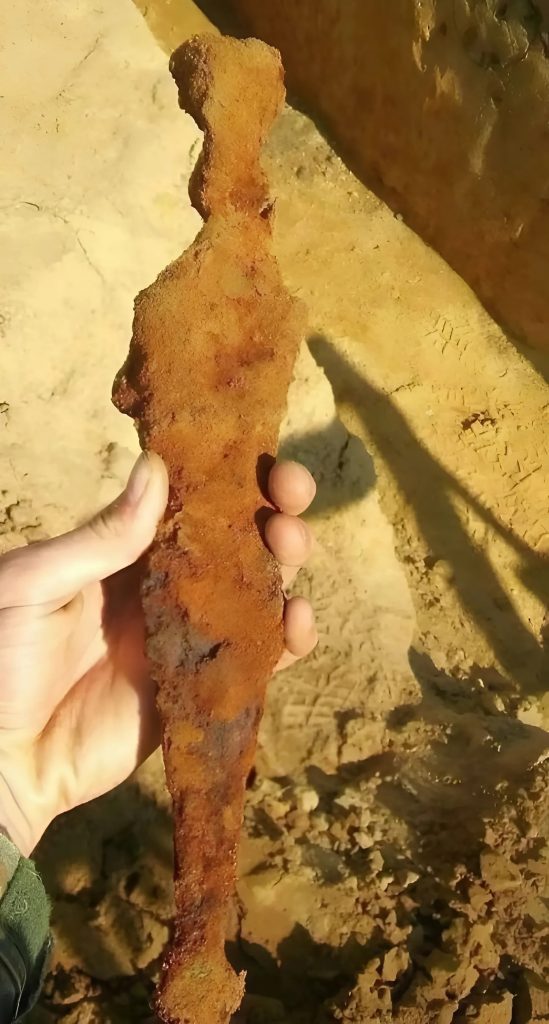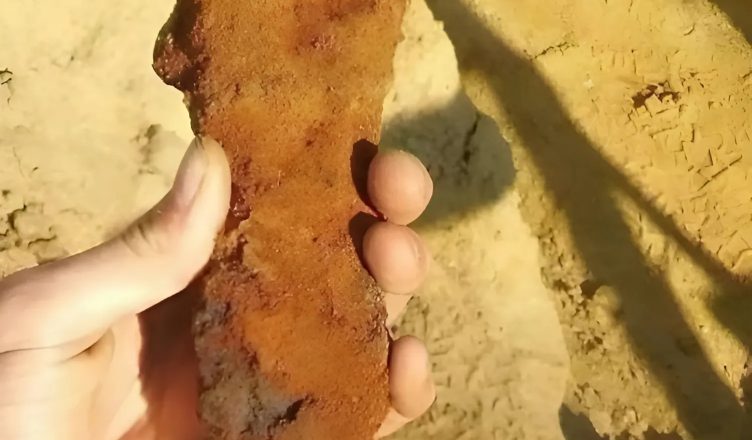In the quiet town of Haltern am See, not far from Münster in western Germany, a group of students and archaeologists gathered in 2019 for what began as a routine excavation of an ancient Roman burial site. Known for its historical ties to the Roman Empire, the site had previously yielded coins, ceramic shards, and personal items typical of Roman military camps. But this time, fate had something extraordinary in store.
Among the group of young archaeologists was a student who, quite literally, stumbled upon history. While brushing through compacted soil, he uncovered an object encrusted in centuries of earth and corrosion. It was only after careful excavation and later restoration that the team realized the significance of what they had found: a Roman pugio, or combat dagger, dating back to the early 1st century AD. What made it extraordinary wasn’t just its preservation—but what it revealed about Roman soldiers, craftsmanship, and even battlefield rituals.
The Discovery: An Ancient Weapon Reborn
At first glance, the object appeared to be little more than a rusted, unremarkable piece of iron. Yet the student’s persistence and the supervision of trained archaeologists ensured the object was carefully removed and sent for conservation. Over the course of nine months, specialists at the Westphalia-Lippe Association for Monument Preservation and Landscape Management (LWL) carried out a painstaking process of restoration. Layer by layer, centuries of corrosion were stripped away, revealing details that had not been seen for nearly 2,000 years.
What emerged stunned even seasoned experts: a fully preserved Roman military dagger, complete with its decorative scabbard and belt fittings, still adorned with intricate patterns, silver inlays, and traces of red enamel.
The Significance: More Than a Weapon
In the Roman military, the pugio was more than just a tool of war. It was a symbol of status, loyalty, and personal pride. Worn by Roman legionaries, particularly centurions and officers, the dagger was both functional and ceremonial. Its short blade made it ideal for close combat, but it also served a psychological purpose—instilling confidence in its bearer and fear in the enemy.

What made this particular pugio exceptional was its level of ornamentation, suggesting it belonged to a high-ranking officer or perhaps even someone of noble lineage stationed at the frontier. The craftsmanship, experts noted, reflected a blending of Roman military utility with artistic expression, unique to the imperial period’s armament.
A Window Into Roman Frontier Life
The site where the dagger was found had long been known as a Roman military encampment from the early imperial era, likely connected to the ill-fated campaigns of Publius Quinctilius Varus, whose legions were famously decimated in the Teutoburg Forest in 9 AD. The burial ground yielded multiple graves, and it is believed that the dagger was deliberately buried with its owner, a Roman soldier who may have perished during one of the violent uprisings in the region.
The presence of the dagger in a grave, fully intact and clearly not looted, indicated ritual significance. It was possibly placed as a funerary offering, a token of the warrior’s life and duty. The dagger’s exceptional preservation raised questions: Was the owner buried with honors? Was this a symbolic act meant to equip him for the afterlife?
Technology and Time: The Power of Restoration
What makes this story even more compelling is how modern technology enabled historians to piece together a narrative from fragments of metal and decoration. With the use of 3D scans, chemical analysis, and digital reconstruction, conservators managed not only to restore the dagger physically, but also to understand its original appearance and function.
Microscopic examination revealed that the blade had once been sharpened to a fine edge, and residual traces on the scabbard suggested it had been worn regularly. Enamel coloring, visible under magnification, hinted at the aesthetic values of the time. This wasn’t merely a weapon—it was a reflection of a soldier’s identity, a piece of personal history forged in iron and art.
A Student’s Find That Changed Historical Understanding
What began as an educational dig for a group of students became a monumental discovery, now housed at the Roman Museum in Haltern am See. The dagger has since become a centerpiece of the museum’s collection, drawing thousands of visitors intrigued by the intersection of chance, history, and human craftsmanship.
This find also reshaped academic discussions around Roman military presence in northern Germania. It offered tangible proof of Roman expansion, resistance, and the personal stories buried—sometimes quite literally—in the soil of modern-day Europe.
